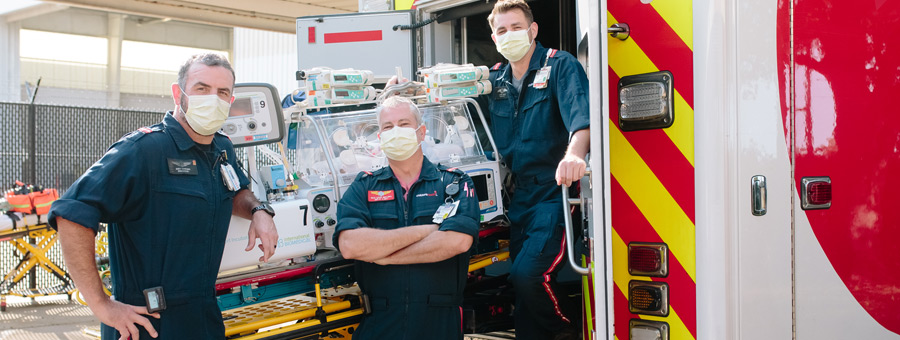When neonates and infants are ill, time is of the essence. Neonatologist Vedanta Dariya recalls a case where a critically ill newborn with a collapsed lung was being resuscitated at a freestanding emergency room and then transported to Children’s Health in Dallas.
“I stayed on the phone with the transport team for about 45 minutes,” says Dariya, M.D., neonatologist and director of NICU Transport at Children’s Health and assistant professor at UT Southwestern. “And every one of those minutes, I was thinking, ‘If I could look at this baby, I wouldn’t need to have the transport team telling me what’s happening while they’re trying to resuscitate him.’”
Now Dariya and the NICU team at Children’s Health can do just that. The hospital, in collaboration with UT Southwestern Medical Center in Dallas, launched a neonatal TeleTransport program, enabling pediatric specialists to evaluate patients and guide their care, even when they are miles away.
Using telemedicine, neonatologists with expertise in Level IV neonatal care work with ambulance transport teams from other hospitals to virtually assess patients and their imaging and test results, speak with the referring doctors and parents, and help optimize the patient’s condition before transport. Importantly, the virtual connection continues during transport, where the physicians can monitor the patients in real-time and provide minute-by-minute care to keep them as stable as possible.
“TeleTransport allows us to bring Level IV expertise to the patient’s bedside at the earliest possible moment,” Dariya says. “That’s going to help more babies survive and thrive, and our experience building the program could be informative to other hospitals who want to create one of their own.”
Tailoring technology to establish the program, the hospital had to overcome several hurdles. Putting telemedicine on wheels requires light, mobile equipment that doesn’t delay transport teams. The technology for both the NICU team and transport nurses must be extremely user-friendly. And TeleTransport equipment must transmit clear video, audio and telemetry data from medical devices without interruption, even as connectivity fluctuates in rural and urban areas and inside hospitals.
To solve for these issues, the transport team is equipped with a cellular-enabled tablet, routers were added to ambulances to provide Wi-Fi hotspots, and the software is simple and intuitive. “The platform was designed so that no matter what needs to be done, the nurses and doctors can get to the solution with the smallest number of clicks,” says Eric McKenney, enterprise solutions architect at Children’s Health.
Piloting TeleTransport
To pilot the program, Children’s Health trained transport nurses on how to use the equipment and incorporate it into their teamwork and emergency procedures. Early cases showed the difference that the remote connection could make.
The first patient to benefit from TeleTransport had an initial blood gas level that was near death. The pH of the blood was low, at 6.89, and carbon dioxide levels were unrecordably high.
The team at Children’s Health visually assessed the patient, watched the monitors relaying the vital signs, and collaborated with the transport nurses to change ventilator settings and administer medications—including blood pressure support and nitric oxide—to stabilize the patient’s critical condition.
“The team was able to do almost exactly what they would have done if they were there physically, and when the baby arrived in our NICU four or five hours later, the blood gas was pH 7.40 and partial pressure of carbon dioxide 42, both completely in the normal range,” says Dariya. “All the interventions that were made during the transport improved the baby’s physiological condition, and a life was saved.”
TeleTransport also allows the physicians and the transport nurses to meet the parents virtually. “The transport nurses can engage with the family so they can understand the specialty care being provided and also meet our physicians who are caring for their child early in the process,” says Scotti Floyd Edgar, director of Transport Services at Children’s Health.
When they transported their first patient with the new technology, the team at Children’s Health was able to explain the critical nature of the patient’s condition to the parents and keep them updated, helping to reduce their anxiety during a stressful time.
Kristin Carlton, program director for Telespecialty and Clinical Outreach, says it also helps ease the parents’ transition to the hospital. “If parents are able to meet the neonatologist and team virtually before transport, when they arrive at Children’s Health, they see familiar faces, adding some level of comfort to a very stressful time.”
Jumpstarting critical care
TeleTransport allows Level IV care to start before the patients reach the NICU. One important example is using therapeutic hypothermia for babies with hypoxic-ischemic encephalopathy, a brain injury that can occur during birth. When babies have been severely depressed at birth and deprived of oxygen or blood flow to the brain, their brain is at risk.
“Hypothermia is the only treatment currently shown to reduce death or disability in this instance, but only if the encephalopathy is recognized immediately and treatment is initiated in the first six hours after birth—time is of the essence,” says Lina Chalak, M.D., neonatologist and director of the Neonatal NeuroNICU Program at Children’s Health and professor at UT Southwestern. “We have invested in a Tecotherm Neo device, the only FDA-approved method for cooling patients during transport, and trained the team on using it as part of the TeleTransport program.”
The sooner the cooling begins, the better the patient’s chances for avoiding brain injury. Typically, the EMT team can’t start the cooling process until they arrive at the hospital, but with TeleTransport, the patient can be actively cooled in the ambulance, allowing them to start the critical therapy sooner. “To determine what patients qualify for this intervention, we need to be able to examine them remotely,” says Dariya. “Then, with certainty, we can tell the transport team to start the process.’”
The future of TeleTransport
TeleTransport is the latest effort in Children’s Health’s goal to extend Level IV care to patients across the region. In partnership with UT Southwestern Medical Center, the hospital developed one of the nation’s most comprehensive TeleNICU programs in 2013. They have virtually examined more than 200 neonates, and more than half of those patients have been able to remain in their home hospitals.
Now the Children’s Health team is looking for ways to virtually connect with more patients and more providers. The next goal is to provide TeleTransport capability on “any and every transport,” says Dariya. “And not just for the NICU. My hope is that our colleagues in the emergency department, pediatric ICU and cardiovascular ICU all find benefit doing this. Any service within this hospital should have the ability to evaluate a sick patient before they arrive.”
This article was originally produced and published by Children’s Health.



